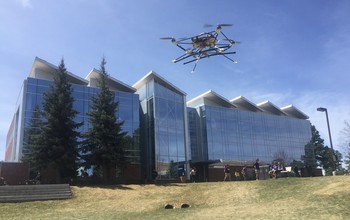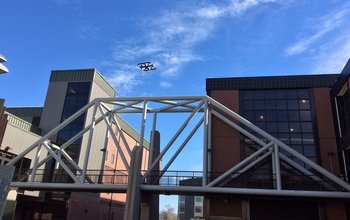All Images
Research News
Turn your eyes to the skies for the latest explorers

A low-level flight test by Michael Shafer and his team at Northern Arizona University.
Credit: Michael Shafer
Download the high-resolution JPG version of the image. (1.7 MB)
Use your mouse to right-click (Mac users may need to Ctrl-click) the link above and choose the option that will save the file or target to your computer.

Hung La of the University of Nevada, Reno is building on NSF-funded research to create UAVs and robotic systems to inspect steel and concrete bridges. His goal is to develop an efficient, low-cost and safe tool for inspecting bridges.
Credit: University of Nevada, Reno
Download the high-resolution JPG version of the image. (365.5 KB)
Use your mouse to right-click (Mac users may need to Ctrl-click) the link above and choose the option that will save the file or target to your computer.

Oklahoma State University research engineer Taylor Mitchell launches a CO2-sensing UAV while the University of Nebraska student team tests in the background.
Credit: CLOUD-MAP
Download the high-resolution JPG version of the image. (1.4 MB)
Use your mouse to right-click (Mac users may need to Ctrl-click) the link above and choose the option that will save the file or target to your computer.
University of North Texas researchers worked with emergency agencies across Texas to test their system's ability to quickly establish emergency communications in disaster drills and exercises. In May 2015, working with researchers from Worcester Polytechnic Institute and the Austin Fire Department, they demonstrated how UAVs can establish aerial communication in a search-and-rescue operation, providing emergency responders with the aerial views they need to direct robots to find victims quickly and transmitting video streams of survivors to control centers.
Credit: Yan Wan and Shengli Fu, University of North Texas
By developing low-cost, UAV-mounted radio telemetry systems that can receive radio signals from tagged wildlife, and by making the pre-engineered systems available to wildlife researchers via open source publishing, they hope to significantly reduce the barriers to tracking animals in the wild. Here, a member of Michael Shafer's research team tests a UAV equipped with a radio telemetry system in a controlled environment.
Credit: Michael Shafer, Northern Arizona University


